- Home
- Jack Canfield
Chicken Soup for the Country Soul Page 5
Chicken Soup for the Country Soul Read online
Page 5
“I’m Joe’s classroom aide,” gleamed Charley. “We were conducting an experiment to see how the kids would respond in his absence.”
“Absence?” My boss was now dumbfounded.
“Bathroom break,” I sheepishly replied.
“Go poo poo!” yelled Donnie, the ringleader of the autistic crew.
“Good boy, Donnie!” hollered Charley as he grabbed Donnie’s hand and led him out the classroom door to the bathroom.
“A joint effort, huh,” the administrator sighed. “I wasn’t aware of such a thing. Dr. Biggs,” the administrator turned to our CEO, “looks like another one of your innovative ideas. You guys never cease to amaze me with what you can do with these kids.”
“Yeah . . . amazing,” my boss muttered under her breath.
Charley looked back at me with a gleam in his eye that was both haunting and heartwarming. He had almost buried me in one moment and saved my rear end in another.
“Conducting an experiment?” I questioned him. “I’m Joe’s teacher’s aide? Charley, you’ve never used big words like that before. What’s going on?”
“Hi, what’s your name?” he turned to me with that haunting gleam in his eye. “My name’s Charwee.”
At that moment it dawned on me I didn’t know this jolly old man even though I had spent countless hours with him on our playground. Where did he come from, and why was he here in a mental institution?
That afternoon, I visited Charley’s other world . . . his fourth-floor ward in one of the archaic adult psych buildings overlooking the sprawling acres and cottages below, where the children and youth programs were located. Behind an old, glassed-in nursing station reminiscent of One Flew over the Cuckoo ’s Nest, I read his chart. Charley was fifty-two years old. When Charley was twenty-six, his father had suddenly died and Charley, who was slightly retarded, was dropped off at the state hospital by his mom. She never came back to get him.
In the blink of an eye, Charley lost his family. In another blink of an eye, twenty-six years had gone by and Charley had not one visitor from the outside world . . . not one. Charley’s best friend was an old blind woman named Irene, who amidst the howls of patients who truly needed to be on the unit, sang “Amazing Grace” with clarity and grit. I can still hear her raspy yet heavenly voice belting out those chords above the helter-skelter sounds of that eerie ward.
And what about Ole Charley? Well, he continued to sneak off from his world and meander down to our autistic neighborhood. “Hi, I’m Charwee. What’s your name?” he would say and eagerly await my reply. “Hello, Joe!” he would laugh as he shook my hand and patted me on the head.
Ole Charley never used big words again around me. He kept things simple. And the kids . . . well, they didn’t care about Charley’s words. They simply loved his laughter and playfulness, his zest for dirt and toilet paper and old faucets and . . .
I would catch Charley watching me every now and then . . . that gleam in his eye, as if to say, “I saved your hide that day.” I knew that he knew.
Ole Charwee.
My teacher’s aide.
My loyal friend.
Joe Pritchard
They’re Waving at Me
Every year, I experience an odd moment shortly after my family and I arrive at the country house we rent in Montana.
I drive down a back road, minding my own business, when I gradually realize that people are waving at me.
They wave from their pickups and cars, barely lifting their hands off the steering wheel. At first the gesture is unsettling. I wonder if they are trying to tell me my lights are on or a tire is flat. Or perhaps it is a case of mistaken identity. I’ve never seen most of these people, so who do they think they are waving at?
Then I remember. I’m not in the city anymore. And if anything distinguishes city folk from country folk, it’s that in rural areas people make a habit of waving at strangers.
Soon I’m waving at everyone too. I lift my fingers a little from the steering wheel, and the other driver lifts his. Or I shift my arm outward a bit as it rests on the window frame, raising my palm, and the other driver does likewise. One needn’t be too obvious or exuberant about these things. A raised index finger speaks volumes, and a simple nod is eloquent in its restraint.
When I pass our neighbor, he salutes me with his customary broad, slow wave, which makes him look as though he’s cleaning a window. His wife waggles her fingers to wave hello; I can almost imagine her saying “Tootle-ooo!” A detective with the sheriff’s office waves as though he’s firing a six-shooter—with the thumb up and a quick jab of the index finger. (I’m still waiting for him to blow away the smoke.)
People in the country will wave whether they’re going sixty miles an hour or ten. They wave on narrow curves, on the crests of hills or driving into a blinding sun. Often they wave in town when they should be watching for pedestrians. In short, they wave at all the times it’s most inadvisable to wave.
If for some reason I forget to wave back—say I’m fiddling with the radio dial—I can’t help but feel a twinge of guilt. Did the people who just waved know me? Were they neighbors? Do they think I’m putting on airs? I worry that I’ve violated one of the cardinal principles of the universe, ordained when the first good person waved hospitably to another from his cave.
To understand the geographical nature of this custom, try a simple test: Wave from your car at strangers along a city street. You may be stared at as if you are crazy. But most likely you will be ignored. I also suspect that if a city person spent a couple of weeks on country roads, he’d be waving just as much as any dairyman, cowboy, logger, beekeeper—or darn-fool visitor like me.
The reason is that, in the country, the human figure stands out against the landscape; it demands recognition. A wave is simply the easiest way of confirming that recognition. But I think waving is also a way of recognizing the setting around the human figure.
I wave at the farmer passing me in a pickup, and my wave extends to the grasses swaying along the roadside, the line of trees tossing in the wind, the billowing white clouds. I wave, and my wave goes all the way to the horizon.
And so, as long as I’m in the country, I’m a dedicated waver. Howdy, I wave to the far range of mountains. Howdy, I wave to the horses trotting in the fields. Howdy, I wave to the kids and dogs romping in the yard.
When I pull into the driveway, my wife waves from the porch. Then she tries to teach our baby daughter to do the same. Howdy, I wave to them. Howdy, I wave. Howdy! Howdy!
Robert Crum
“Don’t worry, it’s just a barn dance.”
Reprinted by permission of Jonny Hawkins. ©1997 Jonny Hawkins.
The Farm Horse That
Became a Champion
If you had been one of the thirteen thousand spectators at the National Horse Show in New York’s Madison Square Garden in November 1959, you would have experienced an unexpectedly moving moment. In the middle of the evening, the arena was cleared, the lights were dimmed and the band struck up a triumphal march. All eyes followed a spotlight toward the entrance gate at the west end of the ring.
There a big gray horse—obviously not a Thoroughbred— appeared, preceded by five small children. As a blond young man and his wife led the horse to the center of the huge arena, the audience rose and began clapping. The applause was deafening. The young couple and their children beamed and bowed their thanks, the horse stomped his feet, and the thunderous clapping went on and on.
The horse was Snow Man, and he was being declared the Professional Horsemen’s Association champion in open jumping—one of the highest honors the horseshow world has to bestow. That he and his owners, the handsome de Leyer family, were receiving such wild cheering was enough to make even the coldest cynic believe in fairy tales.
Less than four years before, Snow Man had been on his way to the slaughterhouse, a tired farm horse that nobody seemed to want or care about. Fortunately, somebody did care—and this is the story of that caring.
/>
One wintry Monday in February 1956, twenty-eight-year-old Harry de Leyer set out from his small riding stable at St. James, Long Island, for the weekly horse auction in New Holland, Pennsylvania. Harry had been brought up on a farm in the Netherlands and had always loved horses. In 1950, he married his childhood sweetheart, Joanna Vermeltfoort, and they came to the United States. With only a smattering of English, and $160 in capital, Harry and Joanna first tried tobacco farming in North Carolina, then worked on a horse farm in Pennsylvania. Soon the two young Dutch immigrants had a few horses of their own, and within five years Harry was offered the job of riding master at the Knox School for Girls on Long Island. Now the father of three children, he was interested, of course, in doing anything he could to build security for his family.
When Harry headed for the Pennsylvania horse auction that February day, he was aiming to buy several horses for the school to use. He arrived late, however; most of the horses had been sold. Wandering outside, he saw several sorry-looking animals being loaded into a butcher’s van. These were the “killers”—worn-out work horses that nobody wanted, except the meat dealer. The sight made Harry sad. He felt pity for any horse, however useless, that could not live out its last years in a green pasture.
Suddenly, Harry spotted a big gray gelding plodding up the ramp. The horse was chunky, but lighter than the others, and there was a spirited pitch to his ears, a brightness in his eyes. Unaccountably, on instinct alone, de Leyer called to the loader to bring the horse back down.
“You crazy?” said the meat dealer. “He’s just an old farm horse.”
Probably, Harry thought. The animal’s ribs showed, his coat was matted with dirt and manure, there were sores on his legs. Still, there was something about him. . . .
“How much do you want for him?” de Leyer asked.
That’s how it all started. Harry de Leyer redeemed an old plug for eighty dollars.
The whole de Leyer family was out to greet the horse the next day. Down the ramp of the van he came, stumbling over his big feet. He looked slowly about, blinking in the bright winter sun. Then, ankle-deep in snow, covered with shaggy white hair, he stood still as a statue. One of the children said, “He looks just like a snow man.”
They all set about turning Snow Man into a horse again. First they clipped him lightly, and then they washed him—three times. In a while, the horseshoer came. Finally, cleaned and curried and shod, Snow Man was ready for his training sessions as a riding horse.
Harry laid a dozen thick wooden poles on the ground, spacing them a few feet apart. To walk across the network of poles, a horse had to lift its feet high and space its steps. When Snow Man tried it, poles flew every which way, and he stumbled and wove.
But Snow Man learned fast. By spring, he was carrying the novice riders at Knox, and some of the girls even began asking for him in preference to the better-looking horses.
When school closed that summer, Harry de Leyer made what might have been the biggest mistake of his life: he sold Snow Man to a neighborhood doctor for double his money, with the understanding that the doctor would not sell Snow Man, except back to him. After all, Harry told himself, he was in the horse business.
Now Snow Man began showing a side that hadn’t previously come to light. He insisted on jumping the doctor’s fences, no matter how high they were raised, and coming home—cross-country over fields and lawns, through backyards and gardens. Irate citizens called the police. The doctor was glad to let de Leyer have Snow Man back.
The feeling was mutual. For in some strange way, de Leyer had come to believe that he and Snow Man shared a common destiny. Solemnly he promised himself never again to part with the horse.
Now, with indication that Snow Man liked to jump, de Leyer began giving him special schooling as a jumper. With kindness and hard work, he helped Snow Man over tougher and tougher obstacles. Finally, in the spring of 1958, de Leyer decided to put the big gray to his first real test—at the Sands Point Horse Show on Long Island, where he would compete with some of the top open jumpers in the land.
Incredibly, out on the Sands Point jump course, Snow Man could do no wrong. Again and again, spectators held their breath, expecting the ungainly looking animal to come crashing down on the bars—but he never did. By nightfall of the second day of the three-day show, he had achieved the seemingly impossible: He was tied for the lead in the open jumper division with the great old campaigner, Andante.
Then, with success so close, on his final jump of the day, Snow Man landed with his feet too close together, and a back hoof slashed his right foreleg. By the following day, it would be swollen and stiff. But de Leyer wasn’t one to give up easily. He cut a section out of a tire tube, slipped it over Snow Man’s injured leg like a sock, tied up the bottom and filled the tube with ice. All night long, he kept the improvised sock full of fresh ice, telling Snow Man over and over how they would win the next day.
When morning came, the leg was neither stiff nor swollen. And on the final round of the day Snow Man beat the mighty Andante!
Harry de Leyer now saw that he had a potential champion— possibly even a national champion. However, giving Snow Man a chance to prove it meant hitting the horse-show circuit in earnest, vanning to a new show each weekend, putting up big entry fees, riding his heart out—a long, tiring summer and autumn that could end in little reward. Moreover, a spot on Harry’s tongue had started hurting, and that worried him. It would be easier to forget about championships. Still, after talking it over, Harry and Joanna decided that Snow Man deserved a try.
So, to Connecticut they went. Snow Man won at the Fairfield Horse Show and at Lakeville. Then to Branchville, New Jersey, but Harry was in no condition to ride a winner. His tongue was bothering him badly, and he had scarcely eaten for a week. Consequently, Snow Man had a bad day. Blaming himself for the big jumper’s first loss, Harry de Leyer drove home that Sunday night gritting his teeth against his pain.
On Monday, he went to a doctor. On Tuesday, he entered a Long Island hospital to have a tumor removed from his tongue. On Saturday, he got the laboratory report: The tumor was malignant. It was the end of the life he had known, the end of Snow Man’s quest for glory.
Harry drove to the Smithtown Horse Show, a few miles from his home, making plans to sell his horses. But somehow he would keep Snow Man. The horse would be turned out to pasture.
Sitting at the show, de Leyer heard his name announced over the loud-speaker: He needed to go home immediately. Harry’s first thought was his children! His second— a fire! He sped home, wondering how much more a man could take. But when he turned into the driveway, the children were playing in the yard and there stood the house. Joanna was close to hysteria, however. A message had come from the hospital that Harry’s laboratory report had been mixed up with another: The tumor was not malignant!
“All of a sudden,” Harry says, “my life was handed back to me.”
From then on, the summer and early fall became one happy rush toward more and more championships at important shows. And finally it was November, time for the biggest show of all—the National at Madison Square Garden.
The National Horse Show lasts eight days. Horses that lack either consistency or stamina are weeded out long before the final night. After seven days Snow Man was tied in the Open Jumper Division with a chestnut mare, First Chance. For their jump-off on the eighth day, the course was long and intricate. It wove around the Garden oval in four overlapping loops; it included quick turns and changes of direction—combinations that call for perfect timing and coordination. First Chance went first. Whether it was the tenseness of the moment, the wear and tear from so many days of jumping or the difficulties of the course, no one can be sure. At any rate, First Chance “knocked” several barriers.
Now it was up to Snow Man to run a cleaner course. Slowly he headed for the first jump. De Leyer nudged him with his knees, and the big gray exploded over it. Now up and over Snow Man went, and up and over again. Over the brush jump, ov
er the chicken coop, the hog’s-back, the bull’s-eye, the striped panel. There were a few touches, but far fewer than First Chance had made. Finally Snow Man approached the last jump.
Now Harry de Leyer sat up in the saddle and threw the reins across the horse’s neck. He was showing, for everyone to see, that it was not he who was responsible for this great performance, it was the horse. Snow Man rumbled up to that final jump, and he thrust and he sailed and it was done! An old and unpedigreed farm horse had won it all—the National Horse Show Open Jumper Championship, the Professional Horsemen’s Association Trophy and the American Horse Shows Association High Score Award. He was declared “Horse of the Year” in open jumping,
Then, in 1960, Snow Man was “Horse of the Year” once more. And if you had been one of the vast crowd that filled Madison Square Garden that November evening to watch the de Leyer family and their big gray receive the ovation, you, too, would have stood . . . and clapped . . . and perhaps even cried—for the victory of a horse and a man who cared.
Philip B. Kunhardt Jr.
Great Love
Any definition of a successful life must include service to others.
George Bush
In the winter of 1990, I was asked to appear on a television talk show in Toronto, Ontario, Canada. At the end of our first day of taping I was on my way back to my plush, high-rise, cable-TV, twenty-four-hour room service hotel, when I saw something I’d never seen before.
Lying on the sidewalk against a building in four inches of snow was a man sleeping with only a cardboard blanket to keep him from being completely exposed to the freezing cold. What really broke my heart was when I realized that he wore no shoes or socks.
I thought to stop and help him but was not quite sure what to do. As the traffic light turned green, it seemed life was demanding that I move along. So I did. Back in the “anything I wanted was mine” environment of my hotel, I promptly forgot about the man on the street.

 Chicken Soup for the Nurse's Soul: Second Dose
Chicken Soup for the Nurse's Soul: Second Dose Chicken Soup for the Ocean Lover's Soul
Chicken Soup for the Ocean Lover's Soul A 2nd Helping of Chicken Soup for the Soul
A 2nd Helping of Chicken Soup for the Soul Chicken Soup for the Nurse's Soul
Chicken Soup for the Nurse's Soul Chicken Soup for the Breast Cancer Survivor's Soul
Chicken Soup for the Breast Cancer Survivor's Soul Chicken Soup for the Pet Lover's Soul
Chicken Soup for the Pet Lover's Soul Chicken Soup for the Bride's Soul
Chicken Soup for the Bride's Soul A Chicken Soup for the Soul Christmas
A Chicken Soup for the Soul Christmas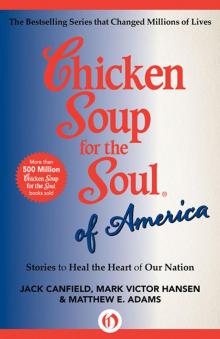 Chicken Soup for the Soul of America
Chicken Soup for the Soul of America Chicken Soup for the Teenage Soul on Tough Stuff
Chicken Soup for the Teenage Soul on Tough Stuff A Taste of Chicken Soup for the Teenage Soul III
A Taste of Chicken Soup for the Teenage Soul III Chicken Soup for Every Mom's Soul
Chicken Soup for Every Mom's Soul Chicken Soup for the Dog Lover's Soul
Chicken Soup for the Dog Lover's Soul A Second Chicken Soup for the Woman's Soul
A Second Chicken Soup for the Woman's Soul Chicken Soup for the Soul the Book of Christmas Virtues
Chicken Soup for the Soul the Book of Christmas Virtues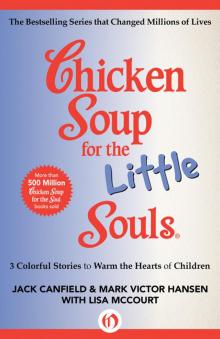 Chicken Soup for the Little Souls: 3 Colorful Stories to Warm the Hearts of Children
Chicken Soup for the Little Souls: 3 Colorful Stories to Warm the Hearts of Children Chicken Soup for the African American Woman's Soul
Chicken Soup for the African American Woman's Soul Chicken Soup for the Soul
Chicken Soup for the Soul Chicken Soup for the Soul Celebrates Teachers
Chicken Soup for the Soul Celebrates Teachers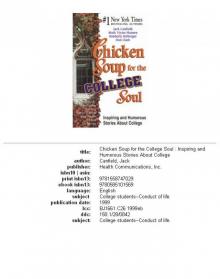 Chicken Soup for the College Soul
Chicken Soup for the College Soul Chicken Soup for the Recovering Soul Daily Inspirations
Chicken Soup for the Recovering Soul Daily Inspirations Chicken Soup for the Soul Celebrates Sisters
Chicken Soup for the Soul Celebrates Sisters Chicken Soup for the Dieter's Soul
Chicken Soup for the Dieter's Soul Chicken Soup for the Soul at Work 101 Stories of Courage
Chicken Soup for the Soul at Work 101 Stories of Courage Chicken Soup for the Beach Lover's Soul
Chicken Soup for the Beach Lover's Soul Stories About Facing Challenges, Realizing Dreams and Making a Difference
Stories About Facing Challenges, Realizing Dreams and Making a Difference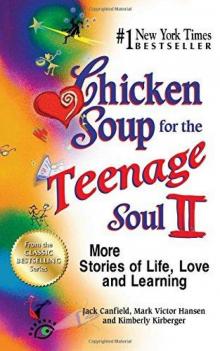 Chicken Soup for the Teenage Soul II
Chicken Soup for the Teenage Soul II Chicken Soup for the Girl's Soul
Chicken Soup for the Girl's Soul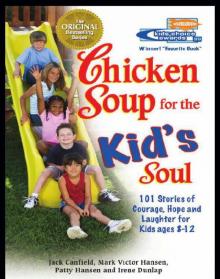 Chicken Soup for the Kid's Soul: 101 Stories of Courage, Hope and Laughter
Chicken Soup for the Kid's Soul: 101 Stories of Courage, Hope and Laughter Chicken Soup for the Woman's Soul
Chicken Soup for the Woman's Soul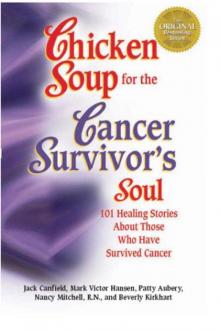 Chicken Soup for the Cancer Survivor's Soul
Chicken Soup for the Cancer Survivor's Soul Chicken Soup for the Canadian Soul
Chicken Soup for the Canadian Soul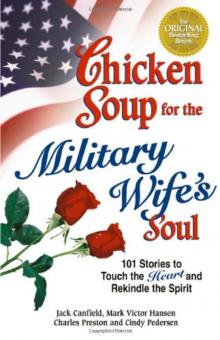 Chicken Soup for the Military Wife's Soul
Chicken Soup for the Military Wife's Soul A 4th Course of Chicken Soup for the Soul
A 4th Course of Chicken Soup for the Soul Chicken Soup Unsinkable Soul
Chicken Soup Unsinkable Soul Chicken Soup for the Soul: Christmas Magic
Chicken Soup for the Soul: Christmas Magic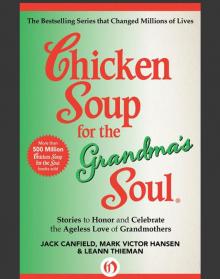 Chicken Soup for the Grandma's Soul
Chicken Soup for the Grandma's Soul Chicken Soup for the Soul: All Your Favorite Original Stories
Chicken Soup for the Soul: All Your Favorite Original Stories Chicken Soup for the Expectant Mother's Soul
Chicken Soup for the Expectant Mother's Soul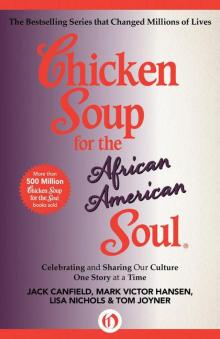 Chicken Soup for the African American Soul
Chicken Soup for the African American Soul 101 Stories of Changes, Choices and Growing Up for Kids Ages 9-13
101 Stories of Changes, Choices and Growing Up for Kids Ages 9-13 Christmas Magic
Christmas Magic Chicken Soup for the Soul: Children with Special Needs
Chicken Soup for the Soul: Children with Special Needs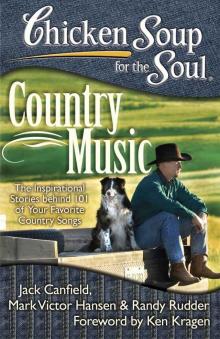 Chicken Soup for the Soul: Country Music: The Inspirational Stories behind 101 of Your Favorite Country Songs
Chicken Soup for the Soul: Country Music: The Inspirational Stories behind 101 of Your Favorite Country Songs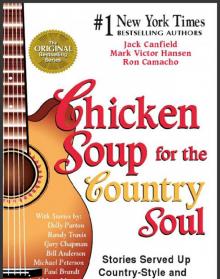 Chicken Soup for the Country Soul
Chicken Soup for the Country Soul Chicken Soup for the Recovering Soul Daily Inspirations (Chicken Soup for the Soul)
Chicken Soup for the Recovering Soul Daily Inspirations (Chicken Soup for the Soul)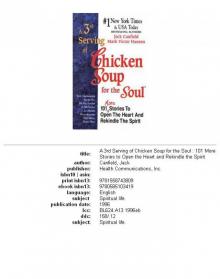 A 3rd Serving of Chicken Soup for the Soul
A 3rd Serving of Chicken Soup for the Soul The Book of Christmas Virtues
The Book of Christmas Virtues Chicken Soup for the Soul at Work
Chicken Soup for the Soul at Work Chicken Soup for the Soul 20th Anniversary Edition
Chicken Soup for the Soul 20th Anniversary Edition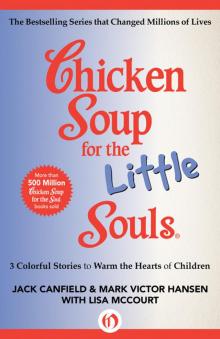 Chicken Soup for the Little Souls
Chicken Soup for the Little Souls Chicken Soup for the Soul: Reader's Choice 20th Anniversary Edition
Chicken Soup for the Soul: Reader's Choice 20th Anniversary Edition Chicken Soup for the Soul Christmas
Chicken Soup for the Soul Christmas Taste of Chicken Soup for the Teenage Soul III
Taste of Chicken Soup for the Teenage Soul III Chicken Soup for the Unsinkable Soul
Chicken Soup for the Unsinkable Soul Chicken Soup for the Preteen Soul II
Chicken Soup for the Preteen Soul II